As we forge our way into 2024, the digital landscape is undergoing profound transformations. Marketers are navigating uncharted technological frontiers and redefining how we connect, create, and consume in the process.
From the nuanced realms of AI and Machine Learning, promising unparalleled personalization and predictive prowess, to the immersive experiences ushered in by VR and AR, the future of digital marketing is here. Are you ready?
As marketers, we need to understand these digital innovations in two ways:
- First, we must understand how new technology is changing the way consumers work, learn, shop, and play.
- Second, we need to use these technologies in our strategies to better connect with consumers and make our marketing more engaging
Our latest Trends Report for 2024, "Digital Horizons," answers these questions.
With insights gleaned directly from Semrush .Trends data, as well as leading data providers like Statista and McKinsey, we delve into five key areas: AI, User Experiences, Consumer Relationships, Digital Content, and Lifestyle Technologies, offering a glimpse into the future.
Consider the 2024 Trends Report as your compass in this journey across new technological frontiers. Let’s take a look at the top 5 trends across the digital marketing landscape.
Trend #1: The AI Revolution is Reshaping Marketing
Inside the 2024 Digital Horizons report, we take a deep dive into recent advancements in AI and the impacts this ever-improving technology is having across industries. Here are a few key takeaways from the data we explore in the report:
- Interest in AI and the use of AI tools has seen explosive growth across the last year
- AI has likely impacted job market growth, especially in fields like content writing and copywriting
Let’s unpack each of these points before we explore some benefits for marketers and offer some tips.
Interest in AI and the Use of AI Tools is Growing Rapidly
The explosion of AI and machine learning represents a paradigm shift in marketing. According to Semrush .Trends data, traffic to AI-related domains increased 1,000% in 2023, highlighting the rapid adoption and integration of AI technologies.
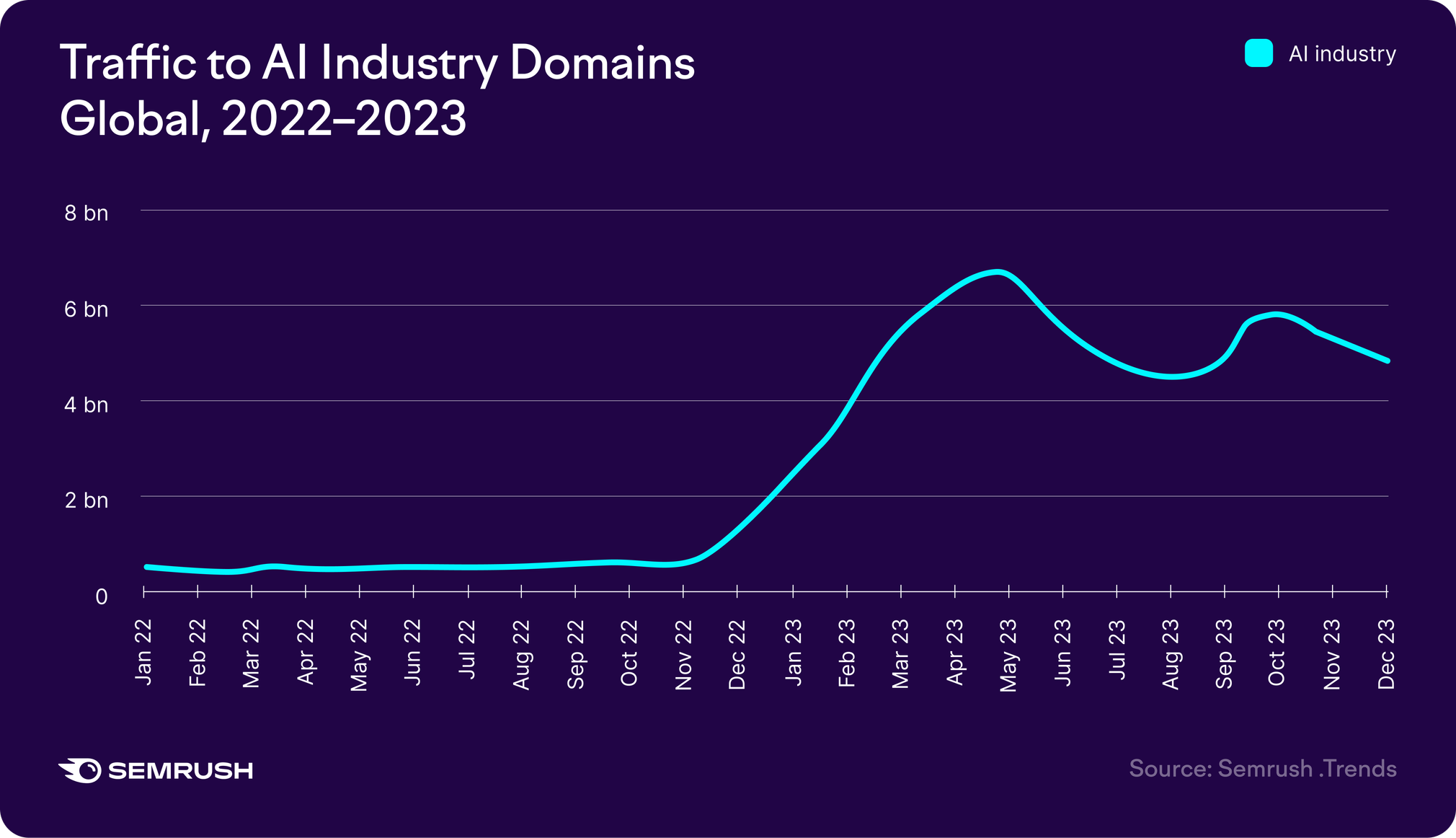
Marketers are already using AI to boost productivity, which is increasing the capacity of internal teams and freeing up marketers for higher-level activities.
According to a 2023 HubSpot survey, 90% of marketers report that AI tools help them more efficiently complete routine and manual tasks.
Here are a few of the most popular AI use cases:
- 48% of marketers use generative AI tools to create content
- 45% of marketers use AI to analyze marketing data
- 38% of marketers use AI to automate specific SEO tasks
With a staggering increase in traffic to AI domains and widespread adoption for content creation, data analysis, and SEO automation, it's clear that embracing AI is pivotal for marketers aiming to stay at the forefront of innovation and productivity.
Looking ahead, AI will become more deeply integrated in the data stack. Creating unique content requires unique inputs. Many businesses have these but haven't leveraged them. As a result, marketing will become more dynamic, data-driven and user-centric."
Robin Allenson
AI’s Impact on the Content and Copywriting Job Market
The rise of AI technologies has had a big impact across the business landscape. While nearly half of marketers report using generative AI in their work, the availability of AI has likely had an impact on the job market.
For example, Job postings with keywords like "copywriter" and "content producer" dropped by more than 70% from 2022 to 2023.
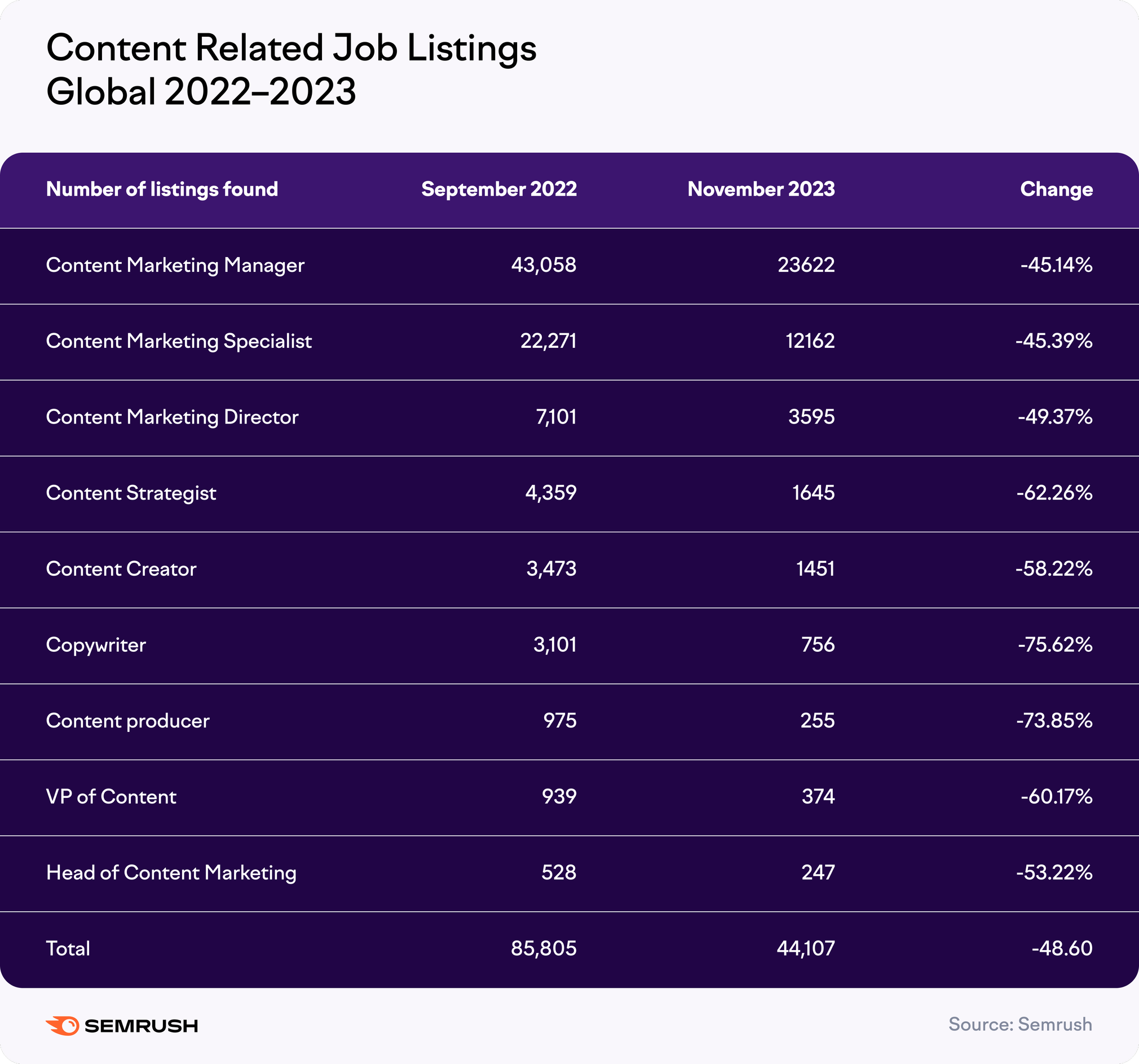
This transformation in the content and copywriting job market reveals the need for marketers to adapt and evolve. As AI technologies become increasingly integral to business strategies and consumer engagement, mastering these tools is no longer optional but essential.
Key Impacts of AI for Marketers
Despite bumps in the road in terms of job growth, the benefits of AI are bountiful. Take, for example, the enhancement in targeting, personalization, and analytics, that leads to heightened engagement and improved ROIs.
For example, Arduino’s application of Twilio’s CustomerAI to tailor marketing messages based on the user's stage in the buyer journey. It differentiated its approach by offering high-intent shoppers detailed information, while new leads received engaging content and incentives, boosting engagement across different consumer segments.
Moreover, AI-driven tools like SAS Customer Intelligence 360 or offer deep insights into campaign performance and market trends, allowing marketers to improve their strategies based on data.
A prime example is Footasylum, which, by leveraging Peak.AI to analyze its data, gained valuable insights into consumer behavior and preferences. This strategic use of AI significantly optimized Footasylum’s customer acquisition strategies, culminating in a remarkable 8,400% return on ad spend, showcasing the potent impact of AI in refining marketing efforts.
A Tip for Marketers: Create Personalized Experiences to Decrease Acquisition Costs
Leverage AI to create personalized experiences for customers, but be sure to protect their privacy. Research from McKinsey shows that personalization can decrease acquisition costs by as much as 50% and boost marketing efficiency by up to 30%.
In 2023, Nike used AI technology to launch a series of personalized designs, providing unique design recommendations to individual customers based on browsing behavior and social media activities.
Trend #2: Advances in Technology are Merging Digital and Physical Realities
How much of your daily life is intertwined with technology? The 2024 Trends Report looks closely at the ever-growing overlap between our digital and physical realities. Here are a few of our key takeaways:
- The Internet of Things (IoT) is redefining how consumers interact with their physical environments, creating new opportunities for marketers
- AR and VR innovations are enhancing marketing experiences and ROIs
Let’s explore these points to understand what they mean for marketers:
The Expansion of the Internet of Things
The web of interconnected devices on our bodies, in our homes, and across our cities is known as the Internet of Things (IoT). Last year, IoT-connected devices increased by 16%—and experts anticipate over 29 billion connected devices worldwide by 2027.
According to Semrush .Trends, in the past two years, visits to the leading 50 IoT-focused websites grew by 19%, particularly those specializing in smart home and smart city technologies.
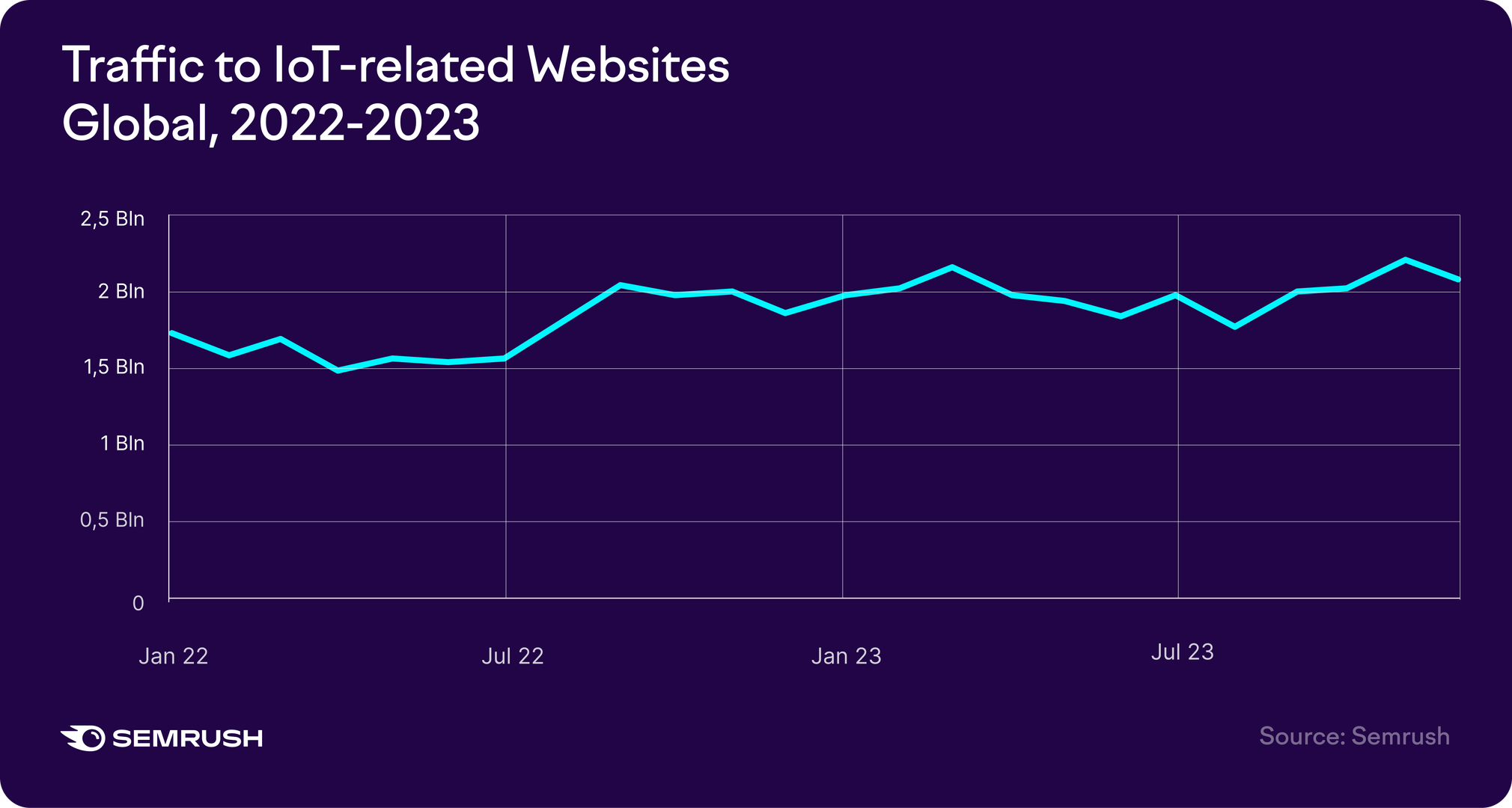
With bountiful access to IoT devices (driven by expanding 5G and edge computing technologies), consumers are entering a new era in user experience. Likewise, marketers are uncovering innovative ways to engage audiences like never before.
Growth in AR and VR technologies
Along with IoT connected devices, augmented reality (AR) and virtual reality (VR) are prime examples of innovations made possible through inter-connected devices and higher data processing speeds.
Consumer interest in AR and VR is also soaring, as shown by the dramatic rise in online searches for leading VR products. From 2022 to 2023, searches for "vision pro" skyrocketed by 2,400%, and searches for "beyond vr" jumped by more than 300%.
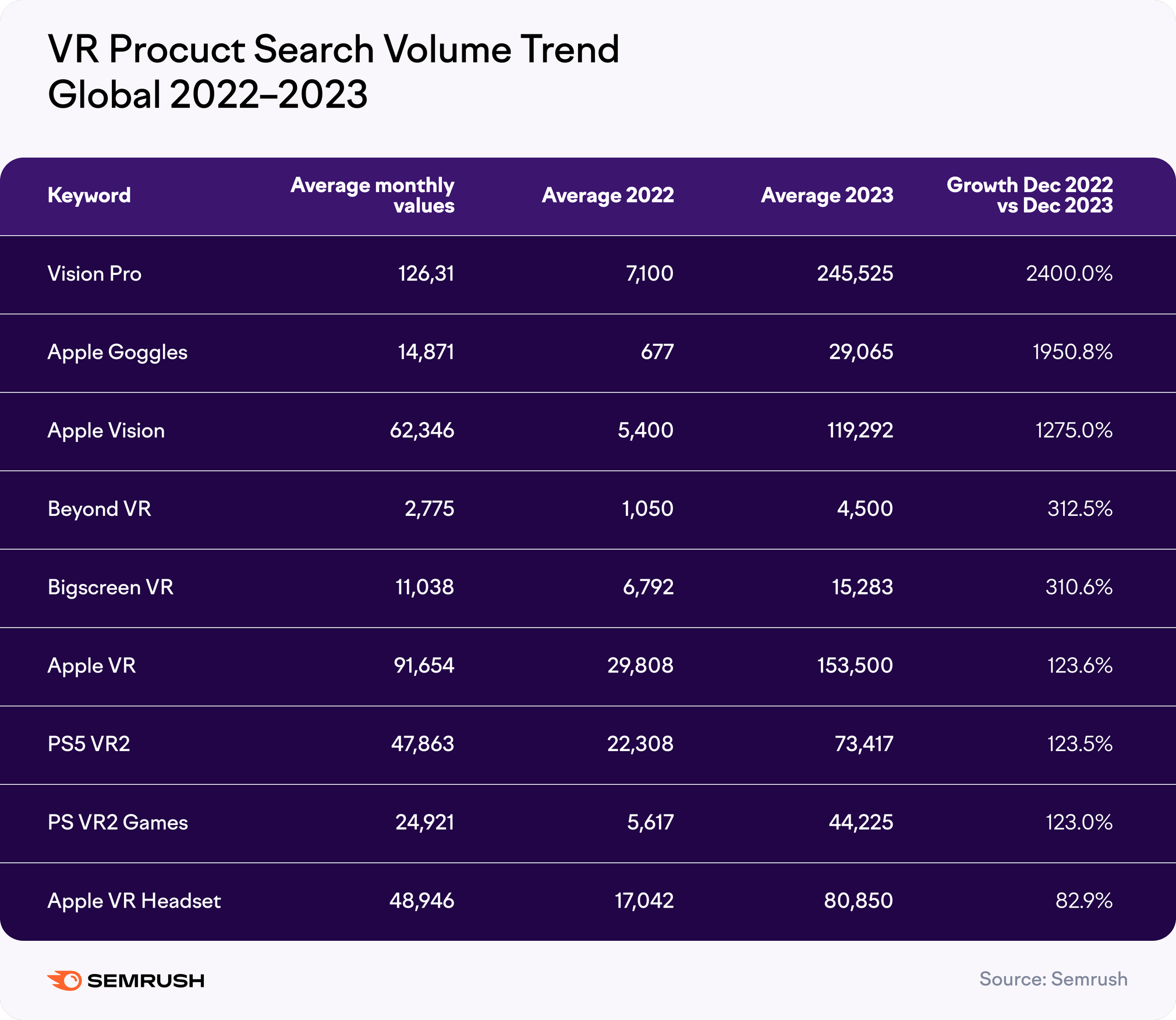
Increases in the quality of AR and VR experiences, along with more widespread accessibility to these technologies, means big gains on the horizon for marketers. Ecommerce applications show particular promise. Research from Shopify indicates that AR experiences can boost ecommerce conversion rates by 40%.
"AR lets you virtually try on clothes, see products in your home, and have interactive demos. It's gamifying and socializing the shopping experience, making it more engaging and shareable."
Key Impacts of IoT, AR, and VR for Marketers
The connectivity spread across the IoT and the speeds with which data can now be processed allows for Location-based marketing (LBM) and immersive AR/VR experiences that are revolutionizing customer experiences.
By leveraging smart devices for geo-location data, marketers at brands like Timberland and Whole Foods are personalizing customer interactions, resulting in significant increases in in-store visits and conversion rates.
Similarly, brands such as Etsy and Ralph Lauren are using AR and VR to enhance the ecommerce experience. These strategies exemplify how digital advancements are creating more interactive and personalized shopping experiences, driving higher engagement and sales.
A Tip for Marketers: Use AR and VR for Product Discovery Opportunities
Look for opportunities to create engaging, immersive experiences using AR and VR. Use ready-made tools to help you implement your strategy. Popular options include Auglio for virtual try-on, Obessar for virtual stores, and Shopify’s virtual scanner for 3D product visualization.
Trend #3: Consumer Focus on Authenticity, Social Good, and Ongoing Relationships Is Increasing
Today’s consumers aren’t like the consumers of the past. In the 2024 Digital Horizons report, we look at behavior trends among consumers and how businesses are adapting to meet their desires. Here are a couple of key takeaways:
- Consumers choose brands that align with their values and interest in social responsibility and sustainability is growing
- Certain business models like direct-to-consumer and subscription models enable authentic, ongoing engagement modern consumers desire
Let’s dive into these trends and explore how they’re impacting the business landscape and the work marketers are doing to connect with new audiences.
Brand Values and Efforts for Social Good are Growing in Importance
Today’s consumers are not just looking for products or services; they’re seeking brands that align with their values, offer personalized experiences, and demonstrate transparency and authenticity.One study found that 76% of consumers would choose a brand they feel connected to over a competitor.
Looking at the traffic numbers illuminates this consumer trend. According to Semrush, traffic to sustainability-related pages among leading e-commerce platforms increased 187% from 2022 to 2023.
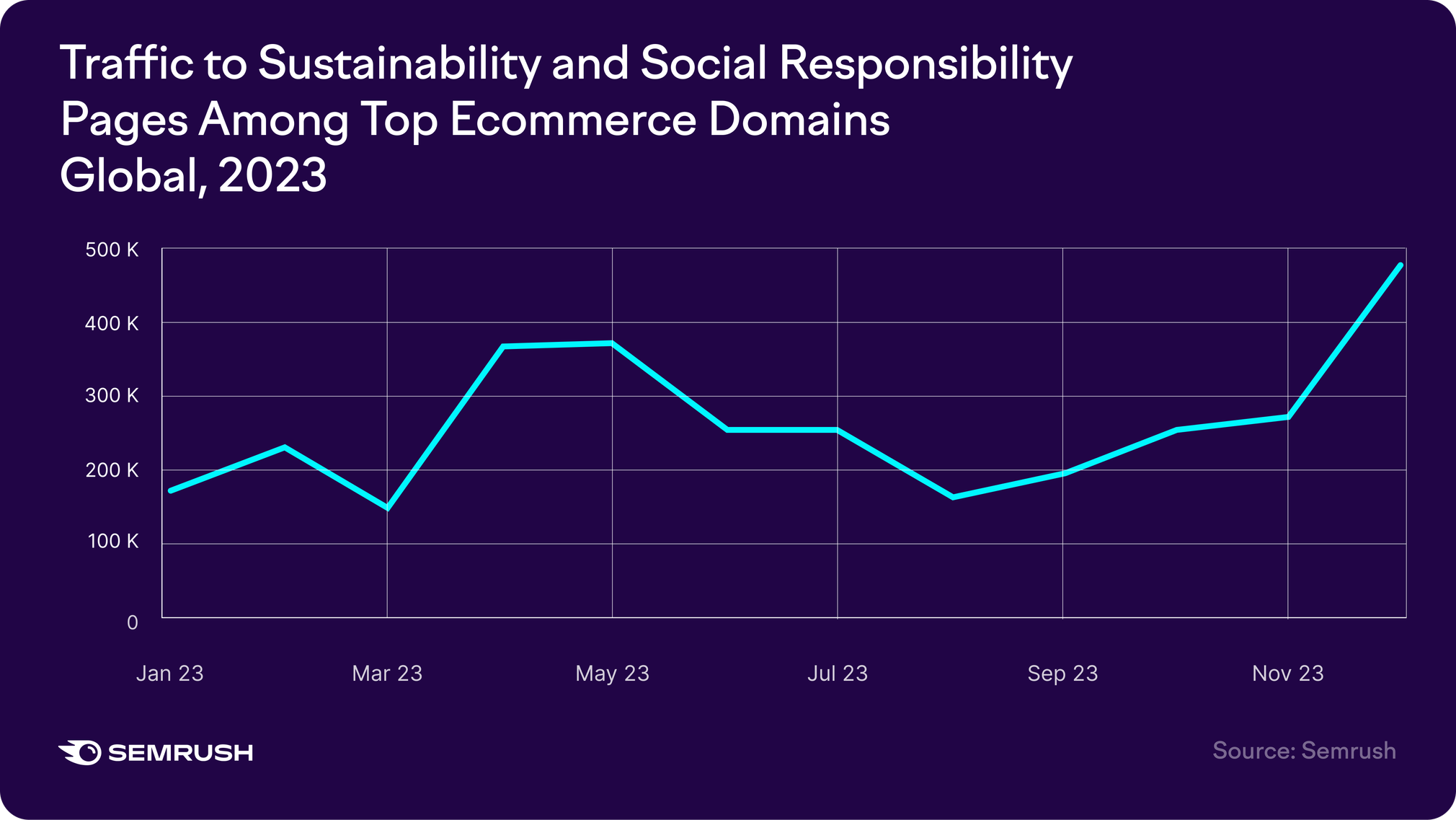
Businesses are responding to these changes by integrating social responsibility into their strategies. They’re also changing how they communicate with customers, promoting social responsibility achievements to improve brand reputation.
While slogans won purchases in the past, winning customer trust is a very different game today when consumers buy experiences and identities. Authentic, value-based communication becomes a necessity.
Building Business Models for Authentic and Ongoing Engagement
To connect with consumers more deeply, businesses are looking to innovative models that allow for more authentic engagement. For example, direct-to-consumer brands posted nearly $200B in yearly sales in 2023.
Along with more direct connections, DTC business models also create opportunities to rethink product offers and pricing structures. Offering subscriptions, bundles, and flexible payment options allows brands to build meaningful long-term relationships with customers.
The subscription-based economy, for example, is expected to reach a market value of $1.5 trillion by 2025, reflecting a growing preference for continuous, curated services over one-time purchases.
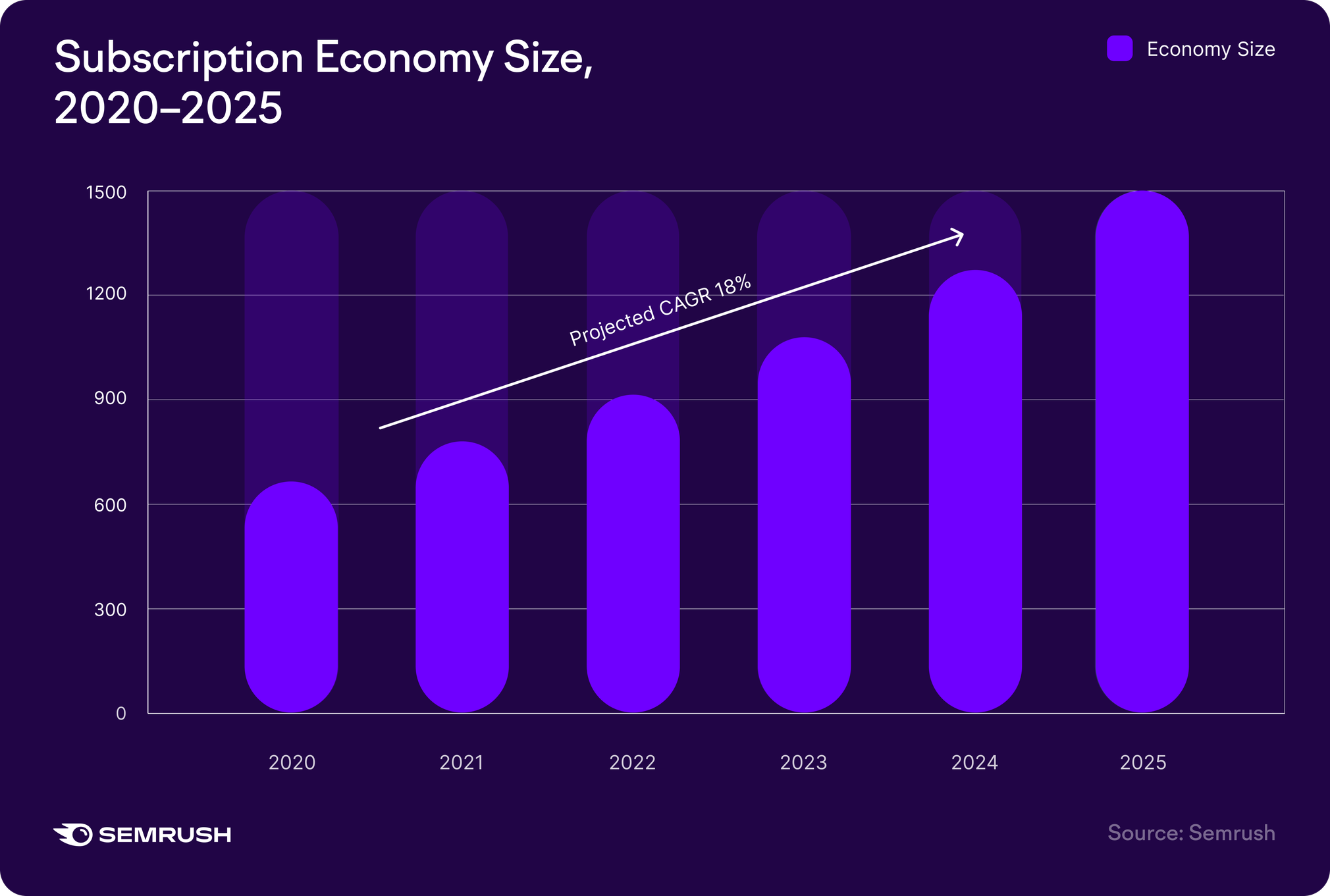
Marketers working for direct-to-consumer (DTC) brands have an advantage in today's business environment, where consumers are looking for more authentic, values-based relationships with businesses.
Key Impacts of Evolving Consumer Preferences for Marketers
Brands are seeing good results in today’s markets by using storytelling about their social responsibility to build trust. This strategy resonates with conscientious consumers and sets brands apart in a competitive market.
For example, Patagonia and Ben & Jerry's set themselves apart by advocating for social and environmental causes. These brands craft narratives that not only highlight their commitment to sustainability and social justice but also resonate deeply with consumers seeking purpose-driven purchases.
Likewise, marketing teams are shifting away from highly polished content toward "authentic marketing." Take Sani, for example, which shares educational and lighthearted “day-in-the-life” TikTok videos of Sani employees selecting fabrics for the brand’s collections or moving boxes into the company’s warehouse.
A Tip for Marketers: Leverage User-generated Content to Build More Authentic Connections
User-generated content (UGC) is inherently personal, authentic, and trustworthy. It’s also particularly popular with younger generations: Research shows that 61% of members of Gen Z prefer UGC to other content forms.
Trend #4: The Digital Content Landscape Is Rapidly Evolving
The changes in the content landscape explored in our 2024 Trends Report didn’t begin yesterday, but the rate of change has increased year over year. Here are some key takeaways from the report related to content:
- Audiences are moving away from traditional media toward streaming, podcasts, and short-form video
- Social media is becoming increasingly vital for product discovery and purchasing
Let’s dive into each trend, explore the data, and discuss how these trends are impacting marketers:
Streaming, Podcasts, and Short-form Video are on the Rise
Although content format preferences tend to vary by age group, some trends—like the popularity of video, for example—cut across age brackets. YouTube reports streaming over 1 billion hours of video daily, and Statista registered a Q3 2023 online video audience reach of 92%.
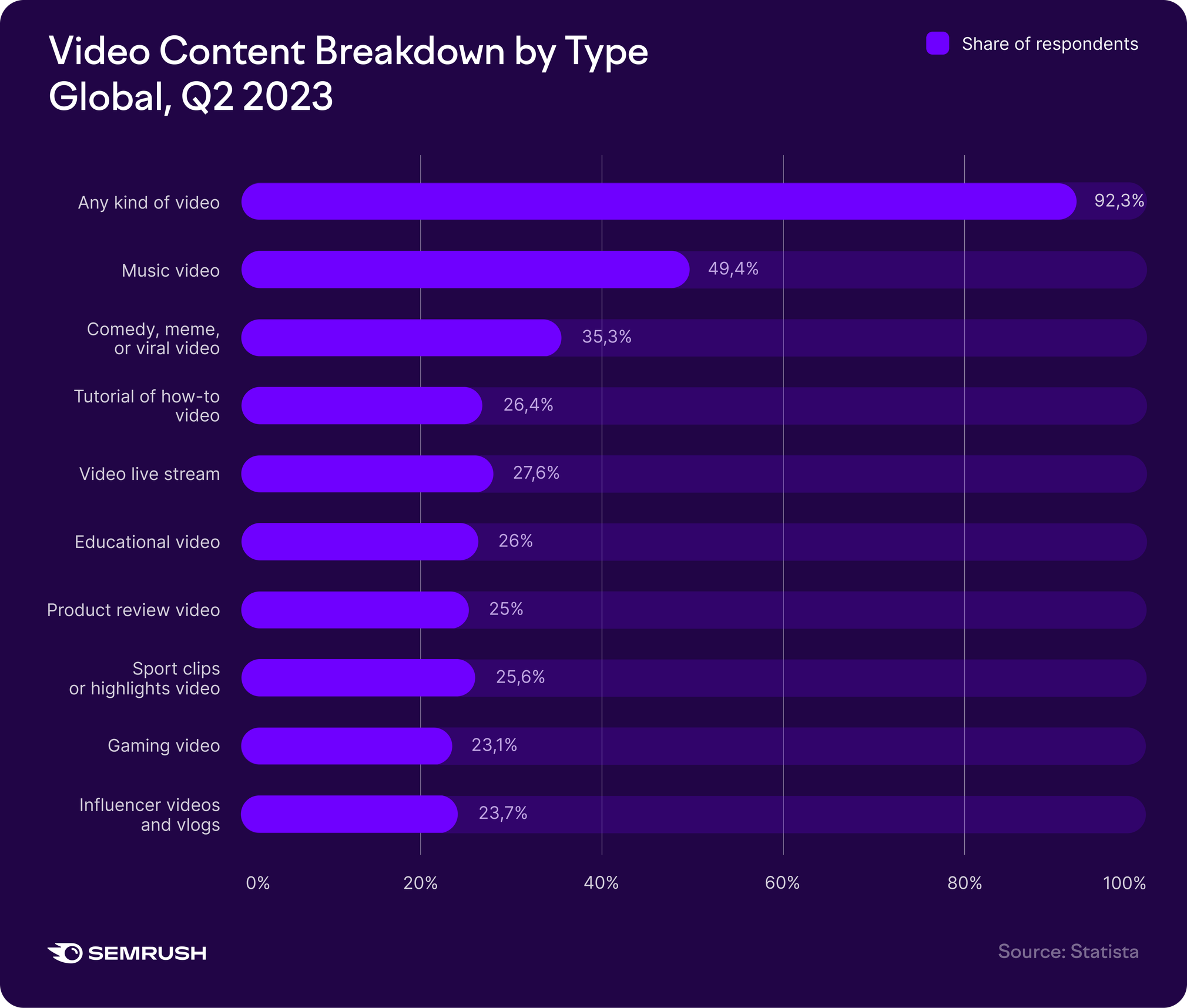
Short-form video—the standout content format of 2023—is expected to lead in 2024, with TikTok, Instagram, and YouTube representing the most popular platforms for short-form video sharing.
Along with short-form video, the increasing popularity of podcasts and the growing influence of over-the-top (OTT) streaming platforms are also particularly relevant trends for marketers.
The OTT video market is estimated to reach $325.4 billion in 2024. And according to Semrush .Trends, traffic to top streamers has grown nearly 59% over the last two years.
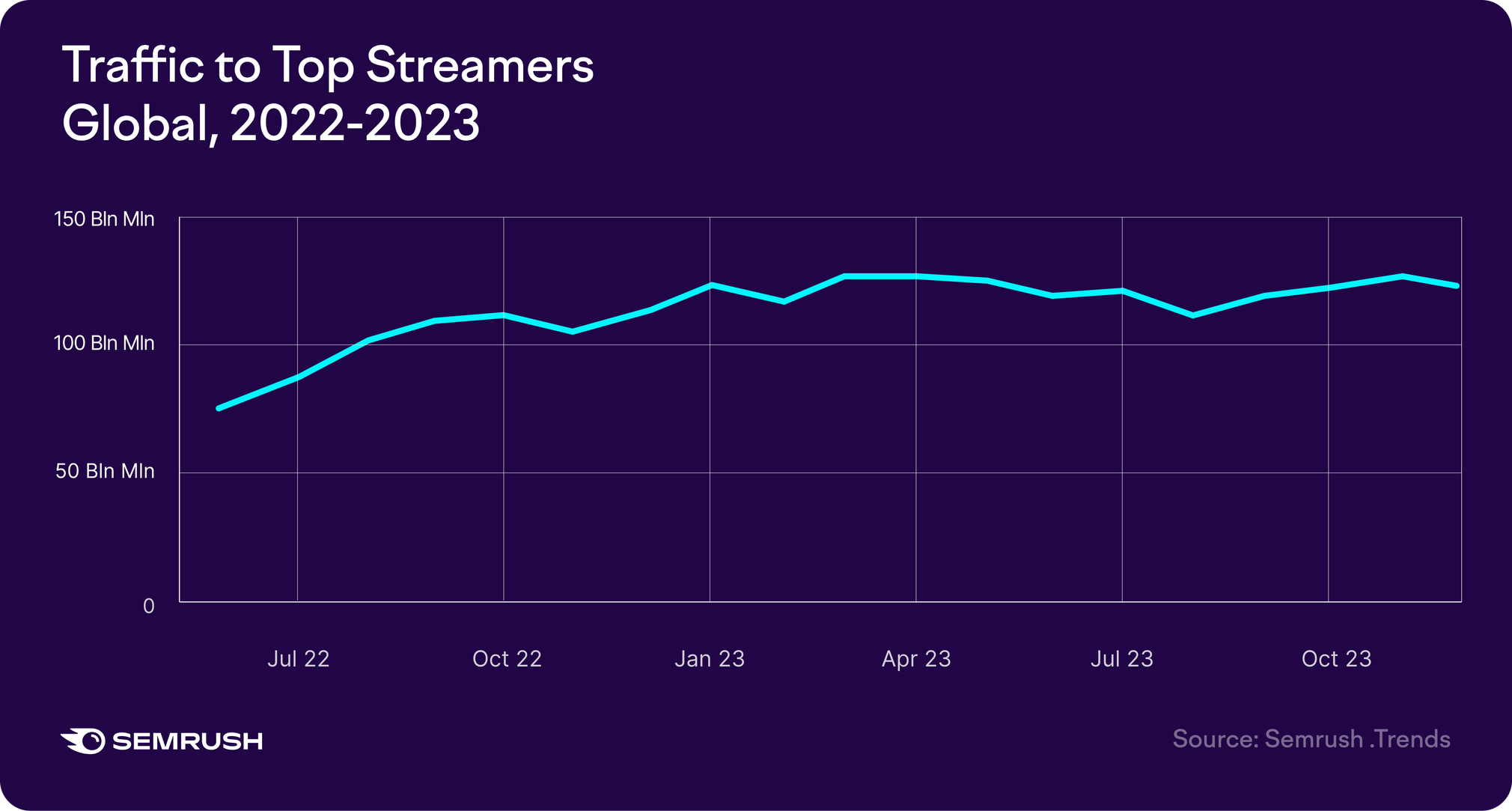
Ad-supported subscriptions are one promising trend in OTT streaming. These plans offer consumers a lower monthly fee, reducing barriers to purchase, while allowing companies to boost revenues by selling ad space. For marketers, this means more advertisement opportunities across more platforms.
Finally, Podcasts present a growing advertising and marketing opportunity. Over 500 million people are expected to listen to podcasts this year, and the podcast industry value is projected to grow from $23 billion in 2023 to over $100 billion in 2030.
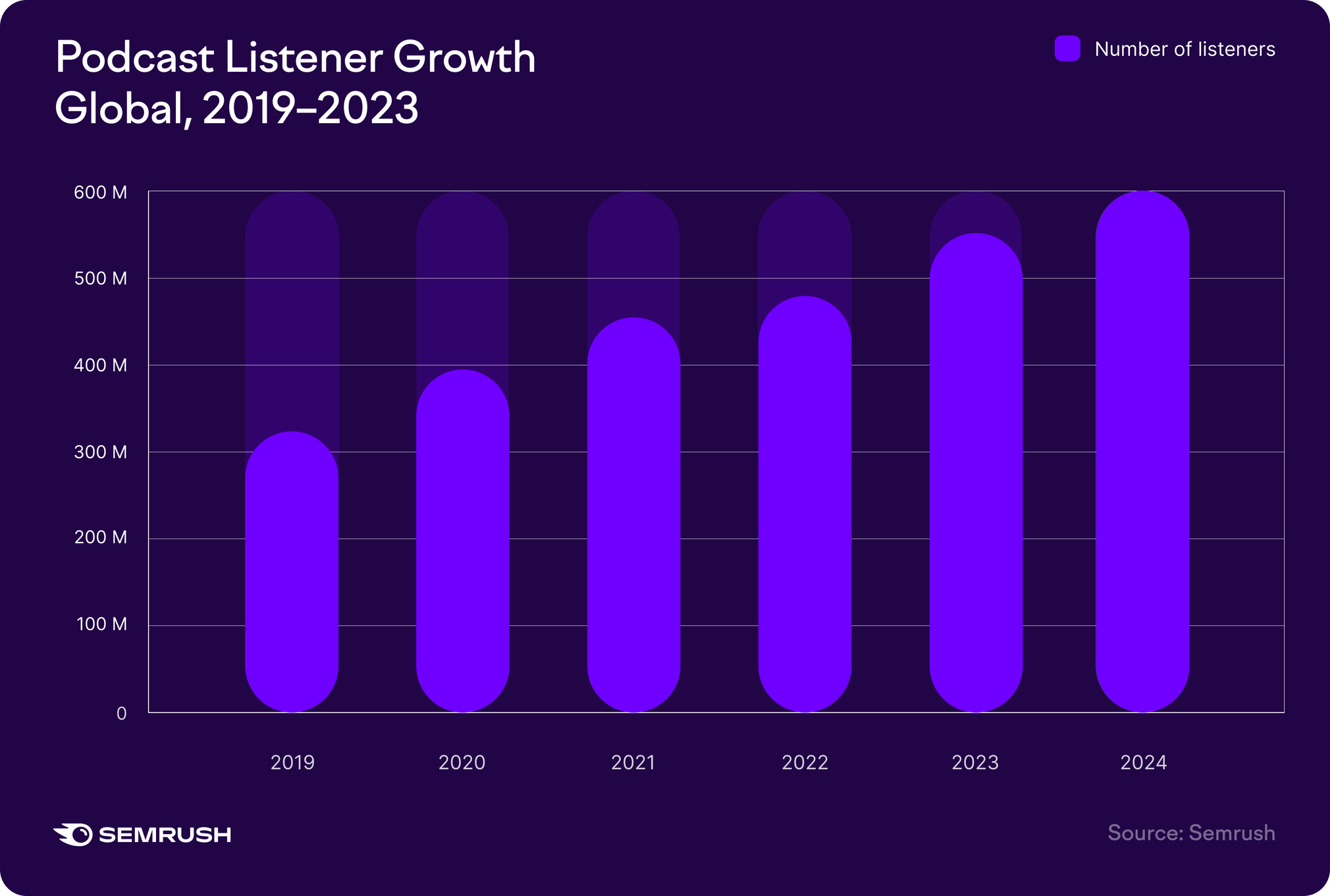
As the podcast form reaches maturity, leaders in the space are monetizing their platforms through exclusive content streams, merchandising, and live events. Many podcasters also sell ad space, allowing marketers to leverage their platforms to connect with consumers.
Social Selling Will Play a Big Role in the Future of Commerce
According to Semrush .Trends data, social media traffic grew by nearly 65% year over year in 2023. Social channels are evolving to meet a wider range of consumer needs, presenting new opportunities for brands to leverage them for sales and marketing purposes.
Consider the increasing popularity of social media for product discovery and purchasing: 50% of consumers worldwide reported using social media to find products
Experts predict that in 2024, 110 million people will purchase on social media platforms in the US alone, a figure that represents 42% of all US internet users and nearly half of all users on social media.
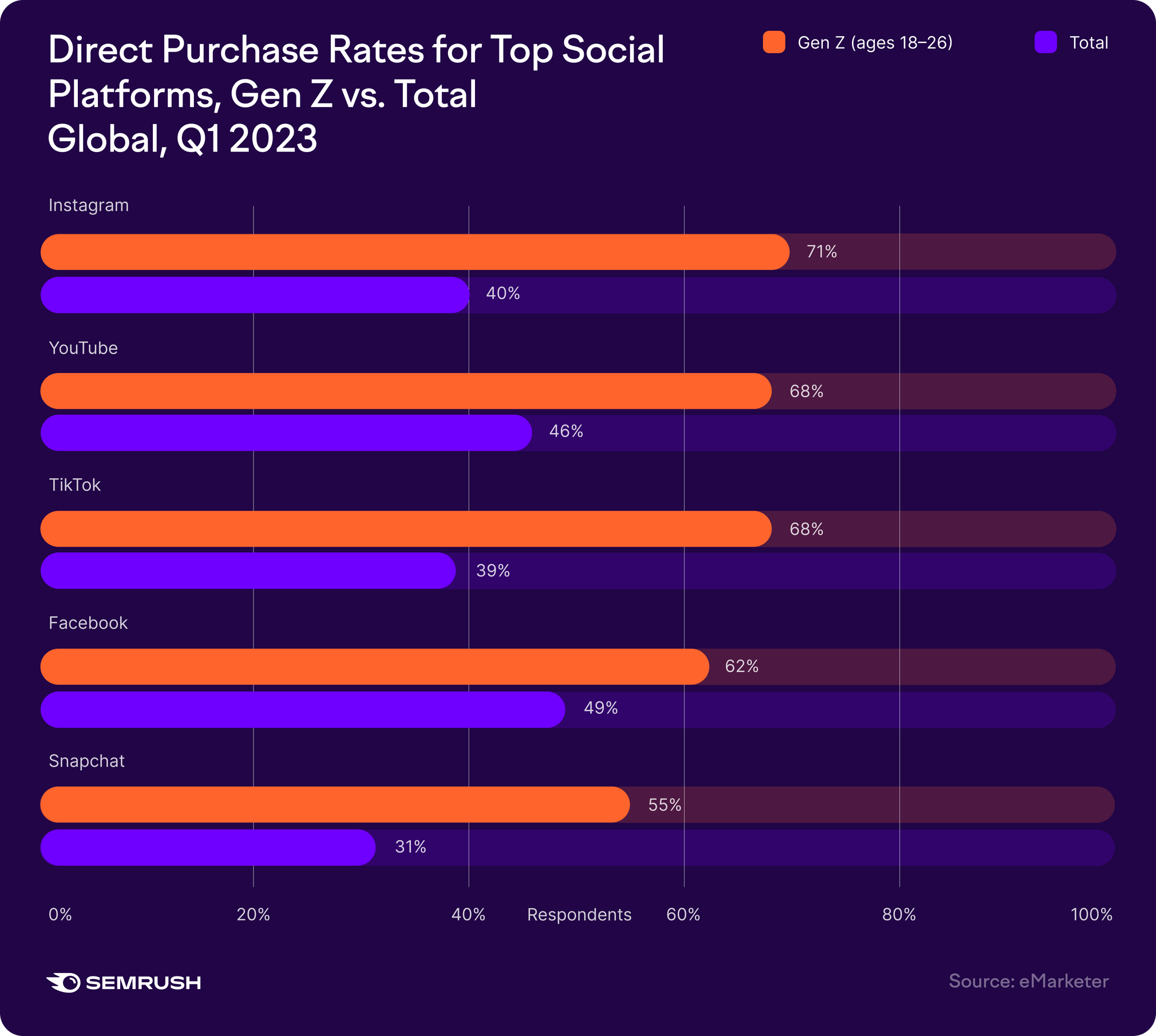
As consumers become more and more comfortable with social commerce, marketers need to understand where their customers prefer to shop, how they find products, and how social content influences purchasing decisions.
Key Impacts of the Evolving Content Landscape on Marketers
HubSpot's 2024 State of Marketing Report highlights the rise of short-form video as the most ROI-effective content format in 2023. This year, 25% of marketers plan to focus on the medium, with over half planning to boost their investment.
Furthermore, there's a growing emphasis on utilizing social media for understanding consumer shopping habits, product discovery, and the influence of social content on buying decisions.
Brands like ColourPop Cosmetics have seen tremendous success using TikTok and Instagram not only for marketing but also as sales channels, highlighting the importance of interactive content and direct engagement with customers.
A Tip for Marketers: Don’t Sleep on Social Selling
As brands ramp up their social commerce strategies, marketing teams can use social selling tools and integrations to improve targeting, increase conversions, and save time.
Some useful methods and tools include:
- Catalog Syncing Integrations– Listing products on social media to showcase your offerings directly to interested audiences
- Shoppable Posts– Transforming organic content into sales opportunities by tagging products directly within posts and stories
- Live Shopping– Hosting real-time product demos and sales
You can explore these options in more depth with providers like Shopify, EmbedSocial, Commentsold, and others.
Trend #5: Lifestyle-related Technologies Drive Industry Change
In the 2024 Digital Horizons report, we look at the technologies impacting our day-to-day lives, focusing on the banking, education, medical, and gaming sectors. Here are a few key takeaways:
- Digital banking, crypto, and decentralized finance (DeFi) are creating access to new markets
- Online education presents new marketing opportunities for businesses
- Gaming industry growth is signaling a major shift in entertainment consumption
Let’s explore these key trends and consider what they mean for the future of marketing.
Digital Banking and Finance Are Making Waves Globally
The landscape of financial services has undergone significant transformation with the advent of digital banking, cryptocurrencies, and decentralized finance (DeFi).
Digital-first banking platforms witnessed a massive increase in traffic in 2023. According to Semrush .Trends data, the top 70 digital-first banks saw a 51.5% increase in traffic volumes compared to 2022.
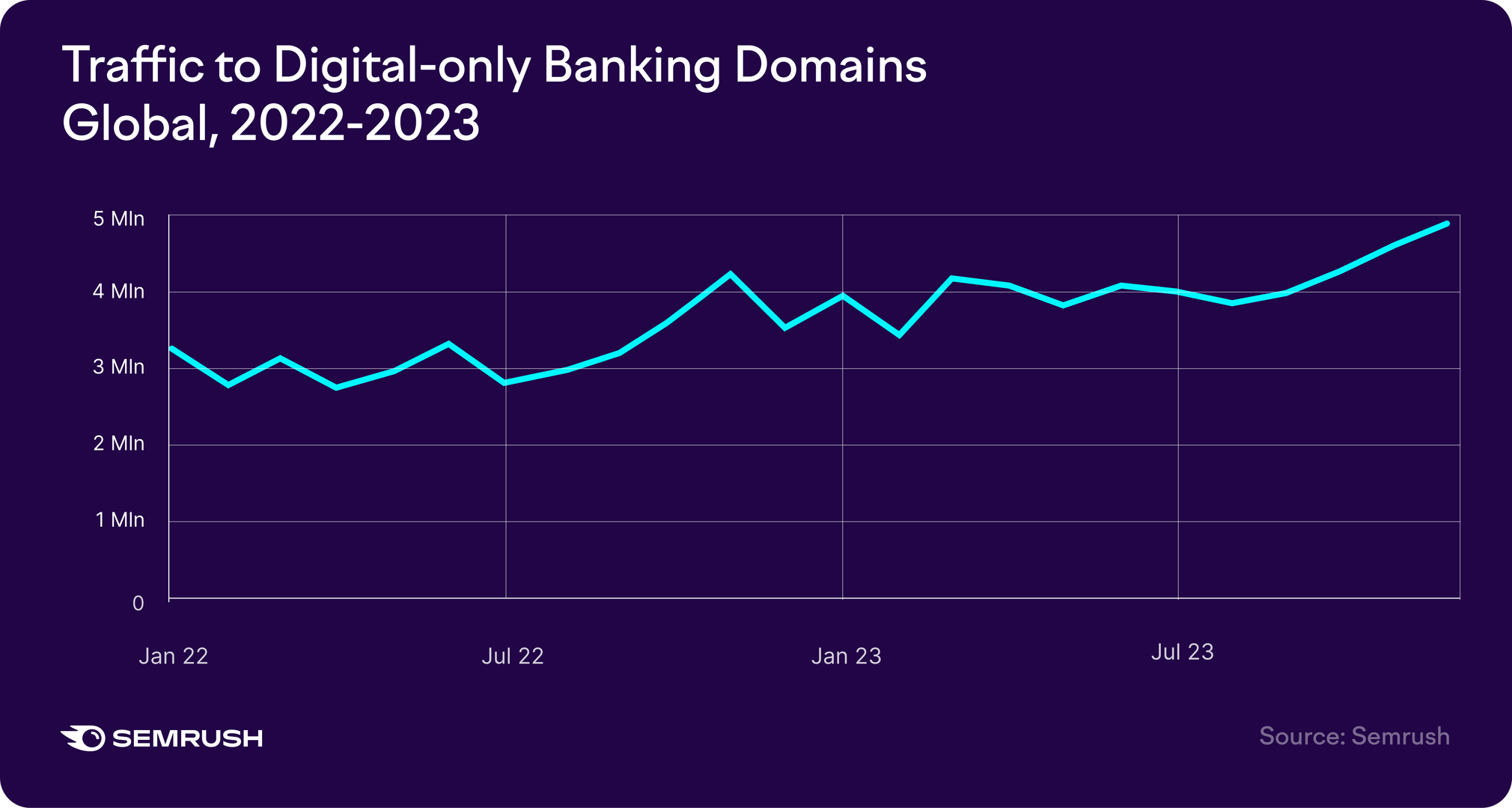
These technologies can make financial services more accessible for populations historically excluded from traditional banking systems, supporting equity and inclusion, while also creating opportunities for businesses and marketers to reach new audiences.
Corporate eLearning Shows an Upward Trend
Digitization is also reshaping the education sector. Research shows that as of 2024, nearly half of students worldwide have completed some form of online learning.
Online education is also becoming increasingly popular with non-student populations. While the overall traffic trend to learning domains has dropped -7% in the last two years, Semrush .Trends data shows visits to corporate e-learning platforms increased 12% year over year.
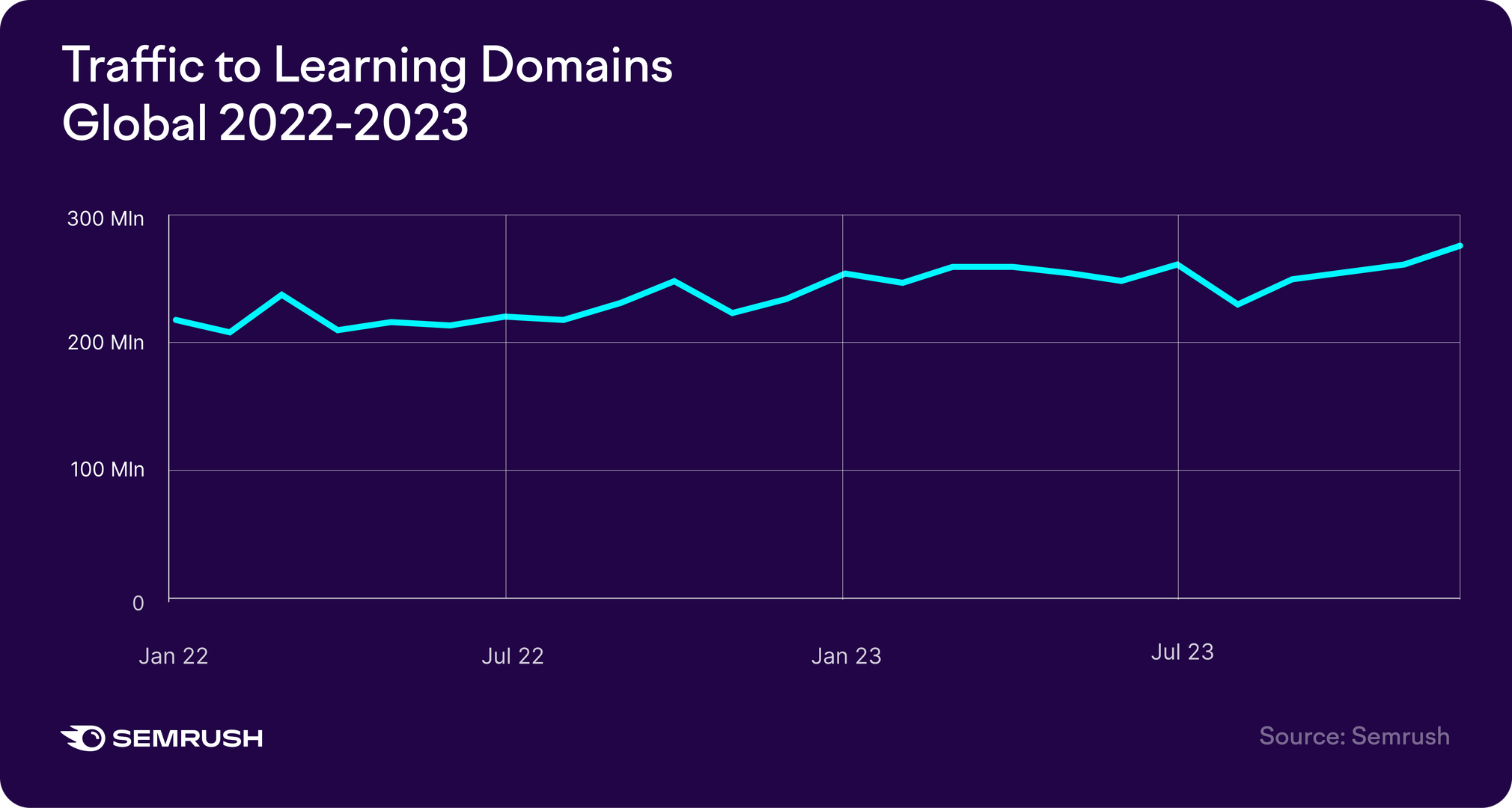
The global corporate e-learning market is projected to reach $550 billion by 2030. Experts anticipate that more and more companies will embrace online workforce and professional development strategies as greater numbers of employees work from home.
Gaming Is Growing Rapidly
Online gaming is becoming more popular each year. Semrush .Trends data shows a 27% increase in traffic to gaming industry domains over the last year, and analysts expect a total industry revenue of $282.3 billion in 2024—exceeding the combined revenue of the movie and music industries combined.
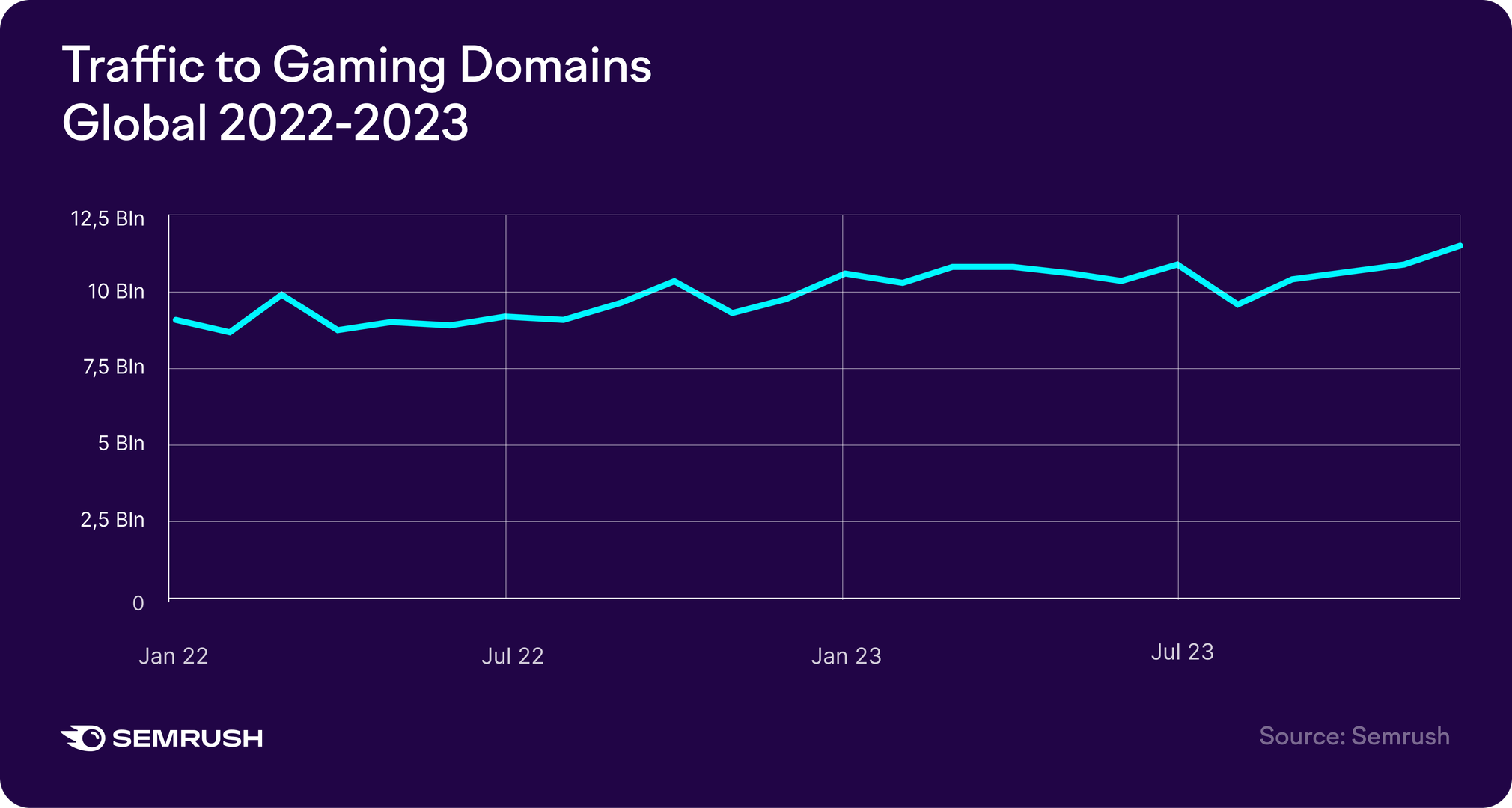
According to Semrush Traffic Analytics, the popular online gaming community Twitch.com received 8 million visits in December 2023, an 11% increase over the same month in the previous year.
As gaming continues to grow in popularity, the industry presents opportunities for marketers to
engage with a broad and diverse audience through targeted advertising, branded content, and partnerships.
Key Impacts of Lifestyle-related Tech on Marketers
Rapid technological advancements in lifestyle sectors enable marketers to tap into new audiences through community-based marketing, especially in areas like wellness, cryptocurrency, and gaming.
This approach is effective as it offers connections to already engaged communities. For example, gaming influencers are popular among males 18 to 34, and brands like Absolut have successfully engaged this audience by partnering with Twitch and gamer, Ricki Ortiz.
Moreover, brands are enhancing trust by offering eLearning and in-app educational content. For example, the Flo app's health library and interactive features have significantly boosted its user engagement and subscriptions.
A Tip for Marketers: Tap the Marketing Potential of Education
Consider using educational content to boost brand awareness and increase authority with your target audiences. You can design educational content for platforms like LinkedIn, Coursera, or Udemy, sharing your knowledge in exchange for a valuable brand-building opportunity.
If your company has a respected name in your field, consider offering certificate programs, like options from Semrush Academy and Hootsuite Academy. Online certification courses can help you reach new audiences, encourage engagement with your products, and even add new revenue streams for your company.
Download the Report for More Data-driven Insights
The marketing landscape is undergoing a monumental shift, driven by rapid technological advances and evolving consumer expectations. The insights shared in this article merely scratch the surface of what's contained in our comprehensive 2024 Trends Report.
